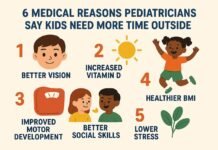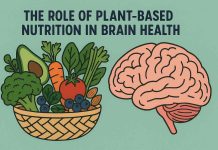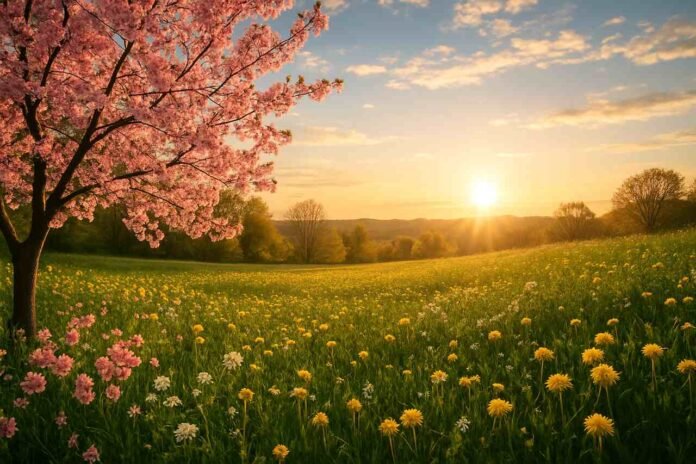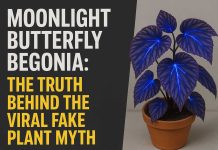Highlights
- The first day of spring 2025 is Thursday, March 20, 2025, in the Northern Hemisphere.
- Spring begins at the exact moment the sun crosses the Earth’s equator heading north.
- Daylight increases rapidly during late March, bringing longer, brighter days.
- The equinox does not give perfectly equal day and night—daylight is slightly longer.
- Spring’s arrival influences weather patterns, seasonal holidays, and cultural traditions worldwide.
When Is the First Day of Spring 2025?
In 2025, astronomical spring begins on March 20 at 5:01 a.m. EDT. This moment is known as the vernal equinox, when the sun shines directly over the equator, creating nearly equal daylight and darkness across the planet.
While meteorologists define spring as starting March 1, astronomical spring is tied to the Earth–sun alignment, making March 20 the official seasonal kickoff for 2025.
Why the Vernal Equinox Marks the Start of Spring
The Earth orbits the sun at a tilt of 23.5 degrees. Because of this angle:
- Different hemispheres receive more or less sunlight throughout the year.
- On the equinox, sunlight hits the equator directly.
- After the equinox, the Northern Hemisphere tilts toward the sun, increasing daylight and warmth.
What happens at the exact moment of the equinox?
- The sun’s rays fall straight on the equator.
- Both hemispheres receive sunlight evenly.
- Daylight begins lengthening at a faster pace.
- Shadows appear shorter due to the sun’s higher path in the sky.
Does the Equinox Really Mean Equal Day and Night?
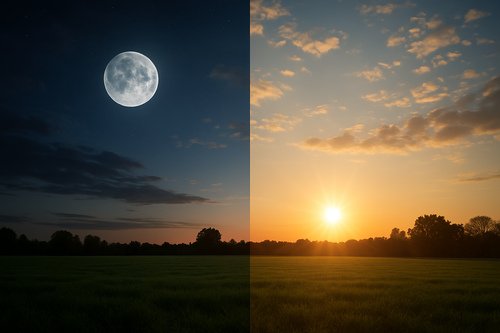
Surprisingly, no. Although “equinox” means equal night, daylight lasts slightly longer than nighttime on March 20.
Why the day is a bit longer:
- Earth’s atmosphere bends sunlight, letting us “see” the sun before it rises and after it sets.
- The sun is not a point of light—it has a visible disk that must fully set.
Most locations gain several extra minutes of daylight because of this atmospheric effect.
How Daylight Changes After Spring Begins
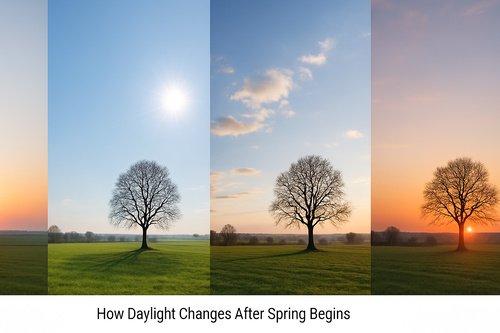
One of the clearest signs of spring is the rapid increase in daylight.
During late March and early April:
- Sunsets become noticeably later each day.
- Day length grows faster in higher-latitude cities (like Toronto or Chicago).
- Locations closer to the equator experience smaller day-to-day changes.
This acceleration in daylight continues until June, when the Northern Hemisphere reaches the summer solstice, the longest day of 2025.
Meteorological vs Astronomical Spring: Why Two Different Dates?
Meteorologists use a fixed calendar system to divide the seasons into equal three-month periods:
- Spring: March 1 – May 31
- Summer: June 1 – August 31
- Fall: September 1 – November 30
- Winter: December 1 – February 28/29
Astronomical spring, however, is based on Earth’s position in orbit and begins with the equinox—March 20 in 2025.
Why meteorological spring exists:
- Easier climate tracking
- Consistent seasonal comparisons
- Simpler for agriculture and environmental studies
Why the First Day of Spring Changes Each Year
Spring does not fall on the same exact date annually because of:
- Leap years
- Earth’s elliptical orbit
- Slight variations in orbital speed
- Gradual shift in Earth’s axis orientation
In rare cases, spring can even begin on March 19 in leap years.
Seasonal Holidays & Cultural Events Connected to Spring 2025

Many traditions, festivals, and holidays occur during or after the equinox. In 2025, several significant celebrations take place in the spring season:
Important dates in Spring 2025
- Eid al-Fitr – March 29
- Passover – begins April 12
- Good Friday – April 18
- Easter – April 20
- Earth Day – April 22
- Cinco de Mayo – May 5
- Mother’s Day – May 11
- Memorial Day – May 26
- Father’s Day – June 15
- Juneteenth – June 19
Many cultures also celebrate the equinox itself through festivals like:
- Nowruz (Persian New Year)
- Mayan equinox gatherings at Chichen Itza
- Druid and pagan sunrise celebrations at Stonehenge
Signs of Spring After March 20, 2025
Spring brings visible and environmental changes soon after the equinox:
Nature & Climate Changes
- Trees begin budding in many regions
- Migratory birds return north
- Temperatures trend warmer (varies by latitude)
- Early flowers like tulips and daffodils bloom
- Wildlife activity increases as days lengthen
Human Activities
- Gardening and planting begin
- Outdoor sports and events resume
- Tourist seasons re-open in many destinations
How Long Will Spring Last in 2025?
In the Northern Hemisphere, astronomical spring lasts from:
March 20, 2025 → June 20, 2025
Because Earth’s orbit is not perfectly circular, the seasons have different lengths. Spring typically lasts around 92–93 days.
Final Thoughts
The first day of spring 2025 marks more than just a date on the calendar—it’s a turning point in daylight, weather patterns, cultural celebrations, and seasonal rhythms around the world. As the sun crosses the equator on March 20, the Northern Hemisphere enters a period of growth, renewal, and longer, brighter days.
Spring arrives the same way every year, but its impact on nature, traditions, and daily life remains just as meaningful as it has for centuries.
FAQs
1. What is the first day of spring in 2025?
The first day of spring in 2025 is Thursday, March 20, marked by the vernal equinox. This is when the sun crosses the equator heading north, bringing the official start of spring to the Northern Hemisphere.
2. What time does the vernal equinox occur in 2025?
The equinox happens at 5:01 a.m. EDT, meaning all regions worldwide experience the equinox at the same moment, adjusted only by time zones.
3. Are day and night equal on the first day of spring?
Not exactly. While the term “equinox” means equal night, atmospheric refraction makes daylight slightly longer than nighttime on March 20.
4. Why does the date of spring change each year?
Spring shifts because of Earth’s elliptical orbit, leap years, and subtle changes in orbital tilt. These variations affect the exact moment the sun aligns with the equator.
5. How long does spring last in 2025?
Astronomical spring lasts until June 20, 2025, ending when the sun reaches its northernmost point during the summer solstice.
6. What holidays happen during spring 2025?
Major observances include Easter (April 20), Passover (April 12), Mother’s Day (May 11), Memorial Day (May 26), and Father’s Day (June 15), along with cultural celebrations like Nowruz and Earth Day.
7. What changes in nature after the equinox?
After the equinox, daylight grows faster, temperatures trend warmer, flowers bloom, and wildlife becomes more active as the Northern Hemisphere leans closer toward the sun.






